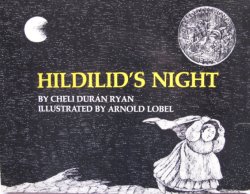Gareth B. Matthews

Review of Hildilid’s Night by Cheli Duran Ryan (New York: Macmillan, 1971). Originally published in Thinking: The Journal of Philosophy for Children 2(2): 3.
Hildilid hates the night. She tries to chase it away, but her very best efforts bring only limited success. Whenever she looks out the window the night is still there – until, of course, the sun rises. That’s about all there is to the story; but that’s certainly not all there is to the thinking the story might set off.
Lynda Wrisley, a kindergarten teacher who took a course I taught a few years ago called “Philosophy and the Young Child,” read Hildilid’s Night to various groups of children between the ages of five and nine. She discussed the story with the children in each group and wrote down some of the conversation that resulted. Here is part of an exchange she had with a group of six- and seven-year-olds. It begins with comments the kids were making to each other, and then Mrs. Wrisley asks some questions.
“You can say it, but you can’t do it. You can’t chase the night away.”
“Yes, you can- with a candle.”
“But the night is still there. If you take away a bunch of dark there is more dark there. ”
(Quiet and thinking)
“What is dark?”
”Just a thing that comes.”
“Where is it in the daytime?”
”It’s on the other side of the world.”
“How does it get there?”
(Lots of ‘I don’t knows’)
“Could someone push it there?”
“No, you can’t push the night.”
“Well, then, what is night?”
“Night is just like air, only darker.”
From a group of children eight- and nine-years old Mrs. Wrisley got the suggestion, “If you want to get rid of night, go to sleep and when you wake up it is gone.”
These older children seem to have been less willing to worry about whether you could chase the night away with lots of light. ”Look,” one said in exasperation, “the earth turns; don’t you know that, Mrs. Wrisley?”
Still, they could respond imaginatively to the question, ‘What is dark?’ One said this:
Dark is just there. When you turn on a light, the light covers it all up like putting paint on the wall. Then when you turn the light off it all goes back into the bulb.
As one might expect, some of Mrs. Wrisley’s children found these discussions more interesting than others did.
To the question, “If I go in the daytime into a closet and turn off the light, is it night in the closet?” one child replied, “No matter when night is night, it is night. Can I go out to play now?” Another sighed and said, I like to sleep a lot. I just wouldn’t be bothered with all this, would you, Mrs. Wrisley?
